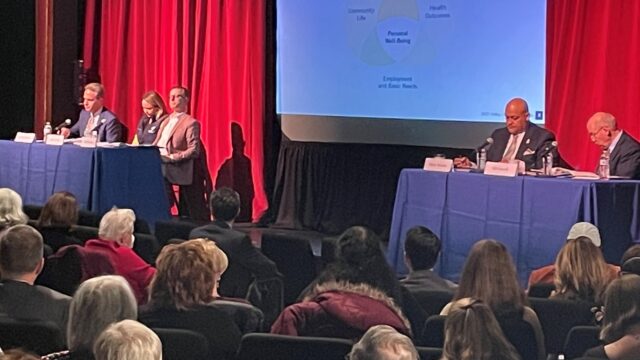2022 Valley Community Index Launch
Regional report highlights changes in Valley health, wellbeing and equity during the last three years.

FOR IMMEDIATE RELEASE
Nov. 15, 2022 (Derby, CT) – Almost all aspects of the Valley’s quality-of-life indicators were adversely affected during the last three years by the COVID-19 pandemic and other factors, according to the 2022 Valley Community Index released to the public Tuesday.
The research, collected and analyzed by DataHaven, a local nonprofit committed to ensuring access to data on well-being, equity, and quality-of-life, highlighted key findings, including housing and food insecurity, lack of affordable high-quality childcare, uncertainty about wages and the economy, and an increase in educational and equity disparities brought on by the pandemic.

“To some, these issues may appear daunting at first,” said Sharon Closius, President/CEO of the Valley Community Foundation, (VCF). “On the contrary, the information included in the Index will be used as a guide and a tool to help us focus on where help and resources are needed most to elevate our Valley.”

This Index also allows Griffin Hospital to meet its federal reporting requirements, and the Naugatuck Valley Health District to meet its requirements for national accreditation by the Public Health Accreditation Board. It also helps lay the cornerstone for work on the next phase of the Valley’s Community Health Improvement Plan, or CHIP.

Area nonprofit organizations, officials, and residents from the region gathered Tuesday at Center Stage Theatre in Shelton for the public unveiling of the 60-page report.
Area nonprofit organizations, officials, and residents from the region gathered Tuesday at Center Stage Theatre in Shelton for the public unveiling of the 60-page report.
The panel of experts at Tuesday’s event included: Patrick Charmel, President/CEO of Griffin Hospital; Jessica Kristy, Director of Health of the Naugatuck Valley Health District; Dr. Reese Morales, Director of Equity and Communications for the Ansonia Public School District; David Morgan, President/CEO of TEAM, Inc.; and Bill Purcell, President/CEO of the Greater Valley Chamber of Commerce.
Since early 2022, workgroups comprised of dozens of area leaders, nonprofits, community stakeholders, experts, and volunteers from the public, worked collaboratively to weigh in on the most pressing needs impacting the Valley region. The Index highlights changing trends and demographics in Ansonia, Beacon Falls, Derby, Naugatuck, Oxford, Seymour, and Shelton.
According to the new Index data, the Valley’s 139,085 population dropped slightly since 2019, about 1,158 people, and the non-White population jumped from 6 percent in 1990, to 26 percent in 2020.
In 2021, approximately 89 percent of high school students graduated on time in the Valley. But during the last three years students who attended school in a hybrid or remote setting performed poorly in achievement testing and had higher rates of absenteeism. The Index data also showed that Black and Latino students, and students learning English, had even higher rates of absenteeism when compared to other students.
In the areas of mental health and addiction, the Valley experienced significant changes. Last year, 65 people in the Valley died from an opioid overdose, and 35 percent of Valley adults say they know at least one person struggling with heroin addiction, or addiction to other narcotics.
The Valley’s economy -- like the country’s -- suffered drastically since the last index report. In the spring of 2020, at the start of the pandemic and lockdown, unemployment in the Valley spiked to 8.7 percent, and the income gap increased for Black and Latina women who earned 67 cents and 51 cents to the dollar when compared to White men.
VCF worked closely with DataHaven, Griffin Hospital and the Naugatuck Valley Health District to produce the Index. It also provided funding and recruited regional stakeholders to share input.
“We were so fortunate to have so many people included in this process this year,” Closius said. “The Index is not just a static document with numbers and graphics that will sit on a shelf. It’s a living document that shines a light on the lives of everyone in our Valley. It shows in detail what’s happened and where we as a community can make improvements.”
